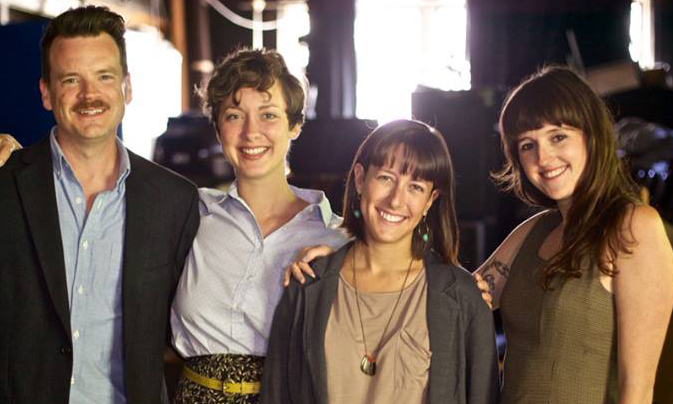Amiri Baraka’s Dutchman—playing for two more shows at Yale Cabaret—was first written and produced when Baraka was still writing under the name LeRoi Jones, his given name, at a time when the Civil Rights movement in America was finally catching fire. Times have certainly changed since then—a fact that “New Black Math,” a poem performed before the play, apprizes us of with its rapid fire listing of traits we might suppose a “Black Play” to have, or not. The point, I think, is to keep us from seeing Dutchman as stuck in its moment, while at the same time letting us know that—whether we feel progress has been made since the Sixties or not—the very notions of “white” and “black” remain very much with us.
And that’s where the play begins: a subway car in NYC, a black man sits reading—poetry, we learn—and a rather provocative white girl gets on. Something might happen between them, or nothing. The girl, who calls herself Lula, wants something to happen; the man, called Clay, could go either way. Lula acts the part of a vamping temptress only too aware of what she’s doing. Gradually she provokes Clay into moving past his guardedness and his politeness, eventually he has to assert himself—with violence. This, we might say, is what Lula has been aiming for; taunting him, teasing him, treating aspects of his life as stereotypical, using outrageous body language to arouse him.
In a wonderfully self-possessed performance by Carly Zien, Lula comes across as extremely manipulative and aggressive—rather than, say, pathetic or scary. Cornelius Davidson gives us Clay’s patience and diffidence, his coolness with regard to what we call today “racial profiling”—Lula’s belittling of his New Jersey origins and “Uncle Tom” aspects. Dutchman dates from a time when the worse insult you could hurl at a self-respecting black man was that he was, essentially, white.
The poetry of Baraka’s play resounds in the back and forth of these two protagonists. It should be said that not all of Lula’s moves are over-the-top; at times, she seems to want to find a common ground, a way for the two to meet free of the racial past and gender divides. As directed by Katherine McGerr, the play cannily keeps before us not simply the appeal and rejection that occur when strangers try to “hook up,” but also the degree to which these characters are “emblematic,” freighted with their social roles as “white woman” and “black man.”
Jones himself was married to a Jewish woman at the time of Dutchman, and there is much in Clay, the would-be “black Baudelaire,” that feels aimed at the author himself. In part, that means a rejection of the expectations of white audiences for the artistic expression of black consciousness through the Black Arts Movement. In that light, Dutchman is almost a manifesto for rejecting the “temptations”—expressed and voiced by Lula, complete with proffered apple—that the white liberal mainstream would saddle black artists with, while “accepting” their work. Dutchman was once very much a play working toward clarity about its own situation.
A strength of the Cab production is that it doesn’t try to recreate any particular time—Clay has earbuds in, so we know it’s our time, more or less—nor does it go overboard in making the situation archetypal. What it maintains is a certain sense of fluidity, that what takes place between the two could go differently, and that what does happen is because of a flaw in the social fabric. In other words, one won’t get too far trying to treat these characters only as realistic subway riders alive in a specific time. Baraka, more famous as a poet than a playwright, knows how to make language act, and is less concerned with character per se.
For those who want backstory and “what happens next,” there is the question of whether Lula actually knows of Clay or if this is a first encounter, and, even more, what happens at the end. The Cab production, which has no bystanders (other than the audience), seems to make the repetition at the end conceivable as a “re-set” that could lead to a different conclusion, with Lula already on the train when “Clay,” or a different black man much like him, enters. The play as written gives one a stronger sense of Lula as more predatory, in a serial search for either a victim or a date. I liked the Cab’s version because it seems to me that the play aims to gesture to an “eternal” situation, rather than a series of discrete encounters.
For me, the main point of the play today—which makes it extremely timely and a great show to revive—is the speech Clay gives to explain his attempt to get along with white society, after Lula provokes him by trying to affront his “manhood” and then his blackness. What Clay gestures to is the possibility of a world where the black man can rise by playing the white man’s game—and thus come to power over his one-time “masters.” What Baraka gives voice to is the perceived threat that many in our allegedly “post-racial” society find in Barack Obama as president. In other words, the racism Dutchman sees is still very much with us and has taken on a new wrinkle in our time.
A play that once seemed rife with the “threat” of interracial sexual relations—still a hot topic in 1964—now seems to play out as a meditation on cultural strategies. In that view, Lula’s temptress moves smack of the “sex card” played by every pop diva, while her own act of violence becomes more ambiguous: a blow against the oppressive male alive in every man? A gesture toward white supremacy (which sees every black man as a threat)? A turning of the tables, where women cease to be victims? However we take it, it’s clear that the nerve Dutchman touches is still a live one.
Dutchman By Amiri Baraka Directed by Katherine McGerr
Producers: Caitie Hannon, Charles J. Felix; Scenic Designer: Adrian Martinez Frausto; Costume Designer: KJ Kim; Lighting Designer: Joey Moro; Sound Designer: Joel Abbott; Dramaturgs: Jennifer Schmidt, Sarah Krasnow; Technical Director: Emily Erdman; Stage Manager: Rob Chikar; Creative Consultant: Yahya Abdul-Mateen II; Photographs: Nick Thigpen; courtesy of Yale Cabaret
Yale Cabaret 217 Park Street
September 26-28, 2013






